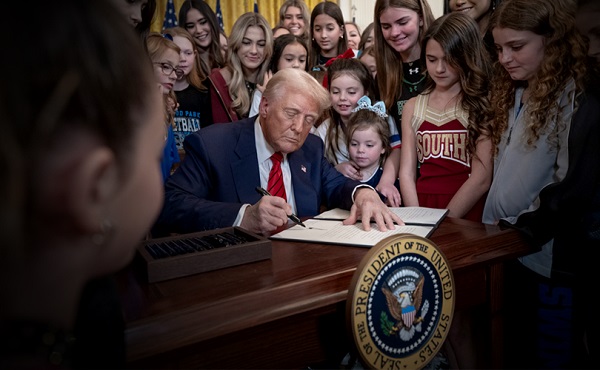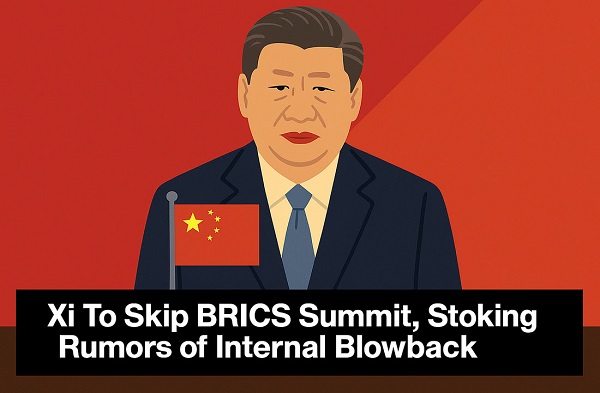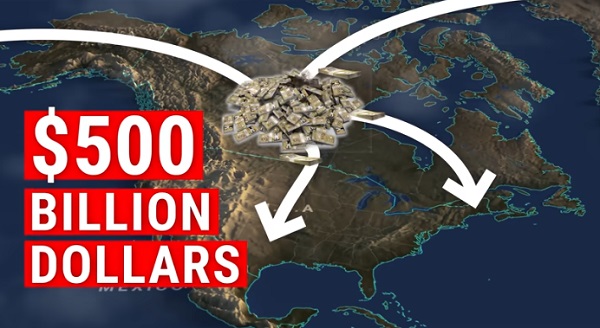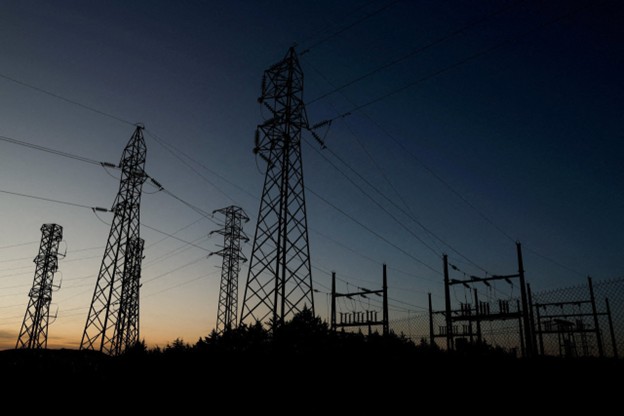International
Trump signs executive order banning gender-confused men from women’s and girls’ sports

From LifeSiteNews
The new executive order declares it ‘the policy of the United States to rescind all funds from educational programs’ that allow gender-confused men to compete against women and girls and extends beyond schools to the Olympics.
President Donald Trump signed an executive order banning men, including those who “identify” as female, from participating in women’s sports in order to “protect opportunities for women and girls to compete in safe and fair sports.”
“The war on women’s sports is over,” declared the president to the delight of the crowd.
“The war on women’s sports is over.” pic.twitter.com/32Z7Htwv8M
— Mike Lee (@BasedMikeLee) February 5, 2025
The scene in the White House East Room on Wednesday where the president was flanked by dozens of women and girl athletes who had been waiting for this moment presented a stark contrast with Joe Biden’s action on his first day in office, when he signed an executive order defending students’ ability to compete in sports based on their perceived “gender identity.”
Prominent in the crowd standing behind President Trump was former collegiate swimmer Riley Gaines who, as the president noted, has been on the forefront of the battle to keep men out of women’s school and professional athletics.
Gaines became a popular, outspoken activist after “losing” to a gender-confused male, William “Lia” Thomas, at a National Collegiate Athletic Association (NCAA) swimming championship in 2022.
Title IX’s original intent restored
“From now on, women’s sports will be only for women,” said Trump.
He warned educational institutions, “If you let men take over women’s sports teams or invade your locker rooms, you will be investigated for violations of Title IX and risk your federal funding.”
READ: ‘Transgender’ males are brutally injuring female athletes, and sports officials don’t care
Passed in 1972, Title IX was enacted in order to prohibit sex-based discrimination in schools that receive federal funding. In recent years, Democrats have contorted its original intent to include gender-confused males and females under its umbrella.
White House press secretary Karoline Leavitt explained that the order “upholds the promise of Title IX” and requires “immediate action, including enforcement actions, against schools and athletic associations” that currently permit gender-confused males to to participate in women’s sports and use locker rooms previously reserved for women and girls only.
‘Demeaning, unfair, and dangerous’ for female athletes, no more
“In recent years, many educational institutions and athletic associations have allowed men to compete in women’s sports,” notes the executive order, aptly titled “Keeping Men out of Women’s Sports.” “This is demeaning, unfair, and dangerous to women and girls, and denies women and girls the equal opportunity to participate and excel in competitive sports.”
“As some Federal courts have recognized, ‘ignoring fundamental biological truths between the two sexes deprives women and girls of meaningful access to educational facilities,’” it continues.
Therefore, it is the policy of the United States to rescind all funds from educational programs that deprive women and girls of fair athletic opportunities, which results in the endangerment, humiliation, and silencing of women and girls and deprives them of privacy.
It shall also be the policy of the United States to oppose male competitive participation in women’s sports more broadly, as a matter of safety, fairness, dignity, and truth.
Trump admin to Olympics: ‘America categorically rejects transgender lunacy’
The president’s directive extends beyond U.S. schools and sports leagues to the upcoming 2028 Summer Olympics to be held in Los Angeles.
Trump authorized Secretary of State Marco Rubio to inform the International Olympic Committee that “America categorically rejects transgender lunacy. We want them to change everything having to do with the Olympics and having to do with this absolutely ridiculous subject.”
He further directed Homeland Security head Kristi Noem to “deny any and all visa applications made by men attempting to fraudulently enter the United States while identifying themselves as women athletes to try and get into the Games.”
NCAA welcomes a ‘clear, national standard’
The NCAA (National Collegiate Athletic Association) seemed to welcome the president’s executive order, saying it provides a “clear, national standard.”
“The NCAA is an organization made up of 1,100 colleges and universities in all 50 states that collectively enroll more than 530,000 student-athletes,” noted a statement by NCAA President Charlie Baker. “We strongly believe that clear, consistent and uniform eligibility standards would best serve today’s student-athletes instead of a patchwork of conflicting state laws and court decisions. To that end, President Trump’s order provides a clear, national standard.”
“The NCAA Board of Governors is reviewing the executive order and will take necessary steps to align NCAA policy in the coming days, subject to further guidance from the administration,” continued Baker. “The Association will continue to help foster welcoming environments on campuses for all student-athletes. We stand ready to assist schools as they look for ways to support any student-athletes affected by changes in the policy.”
Soon after Trump added his signature to his latest executive order, Harvard University fell in line with the order, removing its “transgender inclusion” policy from its athletics website.
LGBT activist groups infuriated
GLAAD, an organization that identifies itself as “the world’s largest LGBTQ media advocacy organization,” was infuriated by the executive order, claiming that men confused about their sex should be recognized as “women” and allowed to compete against women “if they want.”
LGBTQ+ Washington, D.C., lobbying group, the Human Rights Campaign, also attacked the executive order, as did National Women’s Law Center president and CEO, Fatima Goss Graves.
Graves insisted that gender-confused students “do not pose threats to sports” or schools, despite numerous incidents of “transgender” males severely injuring women and girls in competitions, among other harms.
Crime
Suspected ambush leaves two firefighters dead in Idaho

Quick Hit:
Two firefighters were killed and another wounded Sunday after a gunman opened fire on first responders tackling a blaze near Coeur d’Alene, Idaho. The shooter was later found dead, and authorities believe the fire may have been set to lure crews into an ambush.
Key Details:
- The ambush began around 2 p.m. local time as fire crews arrived at a brush fire and were met with sniper-style gunfire from a wooded area.
- SWAT teams located the deceased suspect roughly five hours later, with a weapon nearby. His identity has not yet been released.
- The Kootenai County Sheriff said the ongoing fire could not be addressed during the gunfight, calling the attack a “heinous direct assault” on first responders.
Diving Deeper:
A deadly ambush on Sunday afternoon left two Idaho firefighters dead and a third injured after they were shot while attempting to contain a brush fire on Canfield Mountain. The surprise attack reportedly began around 2 p.m., when bullets suddenly rained down on emergency crews from hidden positions in the wooded terrain near Coeur d’Alene.
Authorities now believe the blaze may have been deliberately set as bait. Kootenai County Sheriff Bob Norris described the situation as “an active sniper attack,” saying the scene quickly escalated into chaos with gunfire coming from multiple directions.
“We don’t know if there’s one, two, three or four [shooters],” Norris said in an early evening press conference. “I’m hoping that someone has a clear shot and is able to neutralize [the suspect], because they’re not showing any signs of surrendering.”
Roughly five hours after the first shots were fired, SWAT officers found a body next to a firearm along the Canfield Mountain Trail. Authorities have not confirmed whether the individual was the sole assailant, nor have they publicly identified the person. The FBI, along with state and local agencies, had been deployed to the scene to assist with the operation.
The two firefighters who died have not yet been named. The third, who sustained a gunshot wound, was transported to Kootenai Health and remains hospitalized. His current condition is unknown.
The firefight effectively halted efforts to contain the brush fire, which remained active late into Sunday. “It’s going to keep burning. We can’t put any resources on it right now,” Norris said during the standoff. Shelter-in-place orders were issued for the surrounding area, including the popular Canfield Mountain Trailhead, but those restrictions were lifted after the suspect was found dead.
Idaho Governor Brad Little reacted to the tragedy on social media, calling the ambush “a heinous direct assault on our brave firefighters.” He added, “Teresa and I are heartbroken. I ask all Idahoans to pray for them and their families as we wait to learn more.”
Federal and local officials are continuing to investigate the incident, including the origins of the fire and whether additional suspects may have been involved.
International
President Xi Skips Key Summit, Adding Fuel to Ebbing Power Theories

First-ever BRICS absence deepens questions over internal CCP dissent
Chinese President Xi Jinping will skip the upcoming BRICS summit in Rio de Janeiro, the first time he has ever missed the gathering of major emerging powers—a development that will add to speculation that Xi’s power among elite Chinese Communist circles is being challenged by a faction publicly humiliated by Xi in 2022.
Beijing cited a “scheduling conflict,” according to multiple officials involved in summit planning, South China Morning Post has reported. But Xi’s absence—coming amid intensifying economic pressures and purges within the People’s Liberation Army—has triggered speculation that deeper internal political currents may be at play.
China’s delegation to Brazil will instead be led by Premier Li Qiang, marking the second time in under a year that Xi has delegated such a high-level multilateral forum. Observers note that Li also stood in for Xi at the G20 summit in India in 2023.
The BRICS platform is a key pillar of China’s push for a multipolar world, challenging the Western-led order.
The official explanation for Xi’s absence—that he has already met Brazilian President Luiz Inácio Lula da Silva twice in the past year—has done little to quell questions about the Chinese leader’s standing at home. Those concerns are being amplified by mounting signs of internal dissent within the Chinese Communist Party, as China’s economy falters and long-suppressed questions about Xi’s hardline tactics against the West, including mounting threats to invade Taiwan, gain traction with the reemergence of a sidelined political faction.
As detailed in a recent Jamestown Foundation analysis, Xi Jinping may be facing renewed political friction from within the Party’s elite ranks—specifically, the so-called Tuanpai, or Youth League faction, aligned with former president Hu Jintao and premier Wen Jiabao.
The history of the Xi-Hu rift is punctuated by a theatrical public humiliation: in October 2022, Hu Jintao was forcibly escorted from the closing session of the CCP’s 20th Party Congress. The moment was captured on live television and interpreted globally as Xi’s final symbolic purge of Hu’s faction. Hu, seated next to Xi Jinping, appeared to reach for documents on the table. Li Zhanshu, seated to Hu’s left, took the papers and placed them out of reach. Xi signaled, and two security staff approached Hu, gently lifting him from his seat and escorting him out. Hu appeared reluctant, attempting to retrieve the documents and briefly exchanging words with Xi. He also patted Premier Li Keqiang, a key figure in the Youth League faction, on the shoulder before leaving. The stunning incident lasted about 90 seconds.
Li died less than a year later, in October 2023, reportedly from a sudden heart attack while swimming in Shanghai. His unexpected death at age 68—soon after leaving office—was officially described as natural, but has fueled speculation among Chinese observers and dissidents, with some questioning the timing and circumstances.
Evidence of the Hu faction’s comeback emerged from the secretive Party retreat in Beidaihe in August 2023. According to Nikkei Asia, and later corroborated by additional sources, three senior Communist Party elders delivered pointed criticisms of Xi Jinping’s policies behind closed doors. All three had ties to the former Hu-Wen administration. Their intervention reportedly provoked visible frustration from Xi, according to individuals familiar with the meeting.
In a possible gesture of appeasement—or vulnerability—Xi has more recently echoed terminology traditionally associated with Hu’s tenure. He invoked the phrase “scientific, democratic, and law-based policymaking,” a hallmark of Hu’s governing lexicon, signaling either rhetorical triangulation or a forced concession to resurgent internal pressures.
The most striking signal of renewed factional maneuvering is the quiet reemergence of Hu Chunhua, according to Jamestown’s analysis, the protégé of Hu Jintao and Wen Jiabao once viewed as a potential future president. Xi sidelined Hu Chunhua in 2022 by excluding him from the Politburo—an unprecedented break from succession norms. But in recent months, Hu has been deployed in high-level diplomatic missions typically reserved for top officials.
In April 2024, Hu led a Chinese People’s Political Consultative Conference delegation to West Africa. The next month, he appeared at the Vietnamese Embassy to pay respects following the death of Vietnam’s former president—a role traditionally carried out by a Politburo-level official.
Xi’s sweeping anti-corruption purges in 2023—many of which targeted military figures linked to the Central Military Commission—have depleted some of his institutional backing. The Jamestown Foundation notes that these purges, rather than consolidating Xi’s grip, may have created new political openings for rivals.
Taken together with broader indicators of factional turbulence, Xi’s BRICS no-show feeds a growing intelligence narrative—shared by The Bureau’s expert sources in the United States and Taiwan—that China’s paramount leader, having consolidated power through sweeping purges, is now encountering mounting signs of blowback from within the Party.
The Bureau is a reader-supported publication.
To receive new posts and support my work, consider becoming a free or paid subscriber.
Invite your friends and earn rewards
-

 COVID-198 hours ago
COVID-198 hours agoOntario man launches new challenge against province’s latest attempt to ban free expression on roadside billboards
-

 Energy16 hours ago
Energy16 hours agoThis Canada Day, Celebrate Energy Renewal
-

 Business1 day ago
Business1 day agoWhile China Hacks Canada, B.C. Sends Them a Billion-Dollar Ship Building Contract
-

 Alberta1 day ago
Alberta1 day agoSo Alberta, what’s next?
-

 Alberta7 hours ago
Alberta7 hours agoAlberta Next Takes A Look At Alberta Provincial Police Force
-

 Bjorn Lomborg1 day ago
Bjorn Lomborg1 day agoThe Physics Behind The Spanish Blackout
-

 Alberta9 hours ago
Alberta9 hours agoCanadian Oil Sands Production Expected to Reach All-time Highs this Year Despite Lower Oil Prices
-

 International10 hours ago
International10 hours agoPresident Xi Skips Key Summit, Adding Fuel to Ebbing Power Theories







